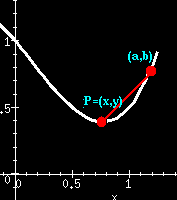 The Definition of Differentiation
The Definition of Differentiation The Definition of Differentiation
The Definition of Differentiation
 We want to find the slope of the tangent line to a graph at the point
P. We can approximate the slope by drawing a line through the
point P and another point nearby, and then finding the slope
of that line, called a secant line. The slope of a
line is determined
using the following formula (m represents slope) :
We want to find the slope of the tangent line to a graph at the point
P. We can approximate the slope by drawing a line through the
point P and another point nearby, and then finding the slope
of that line, called a secant line. The slope of a
line is determined
using the following formula (m represents slope) :

 Let P = (x,y) and
Q := (a,b). Let
Let P = (x,y) and
Q := (a,b). Let

Then the slope of the line

 Now, we
chose an arbitrary interval to be Delta-x. How does the
size of Delta-x affect our estimate of the slope of the
tangent line? The smaller Delta-x is, the more accurate
this approximation is. There is a wonderful animation of this by Douglas
Arnold. Look at it here.
You can see on the left of the animation how Delta-x
decreases, causing the secant line the approach the tangent, where it
zooms in on the right. Another animation of this (also from Douglas
Arnold) is here.
Now, we
chose an arbitrary interval to be Delta-x. How does the
size of Delta-x affect our estimate of the slope of the
tangent line? The smaller Delta-x is, the more accurate
this approximation is. There is a wonderful animation of this by Douglas
Arnold. Look at it here.
You can see on the left of the animation how Delta-x
decreases, causing the secant line the approach the tangent, where it
zooms in on the right. Another animation of this (also from Douglas
Arnold) is here.
 What we want to do is decrease the size of Delta-x as
much as possible. We do this by taking the limit as
Delta-x approaches zero. In the limit, assuming the limit
exists, we will find the exact slope of the tangent line to the curve at
the given point. This value is the derivative;
What we want to do is decrease the size of Delta-x as
much as possible. We do this by taking the limit as
Delta-x approaches zero. In the limit, assuming the limit
exists, we will find the exact slope of the tangent line to the curve at
the given point. This value is the derivative;

 There are a few different, but equivalent, versions of this definition.
In more general considerations, h is often used in place of
Delta-x. Or Delta-y is used in place of
There are a few different, but equivalent, versions of this definition.
In more general considerations, h is often used in place of
Delta-x. Or Delta-y is used in place of

This leads to three commonly used ways of expressing the definition of the derivative:

Back to the Calculus page | Back to the World Web Math top page